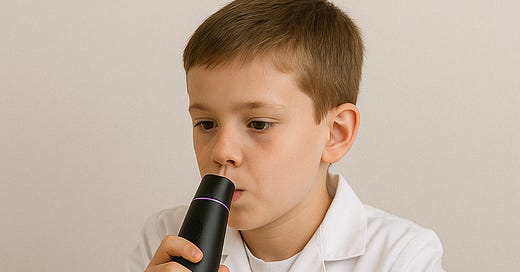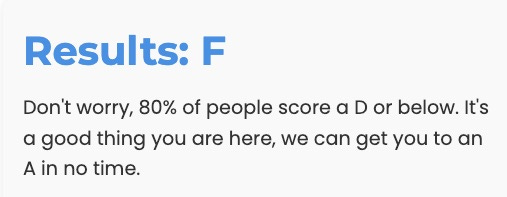Personal scientists know that breathing—something we do roughly 20,000 times daily—can reveal surprising insights about our bodies.
New tools promise insights into metabolism, digestion, and even stress levels—all from a single exhale. They’re part of a broader trend of breath hacking: turning your respiration into a real-time diagnostic tool, or even a lever to control your health.
Measure Your Breath
Personal scientists are suckers for simple, quick tests so when a friend told me about Dr. Belisa Vranich and BreathingIQ, I immediately gave it a try. I used a tape measure to compare my inhale and exhale chest size and answered a couple of questions to determine that I’m a “vertical” breather. The site then emailed me the following report a few minutes later:
So, what does your F grade mean? In simple terms, it means that your breathing is inefficient. You're still getting air in and out of your body, but you're relying on the smaller, auxiliary muscles of your neck and shoulders instead of your diaphragm. This leads to faster, shallower breaths that don't fully engage your lungs.
You might find it challenging to slow down your breathing or feel like you're not getting enough air. This can result in digestive issues like acid reflux or lower back pain due to lack of support in these areas. Poor breathing habits can also impact your emotional well-being, causing feelings of anxiety or stress and potentially raising your heart rate and blood pressure.
The site recommends Inspiratory Muscle Strength Training (IMST), a type of resistance training for the muscles used in breathing, particularly the diaphragm and intercostal muscles. It involves inhaling against resistance, often using a handheld device, to build strength and endurance. Apparently, IMST can help by strengthening these muscles, potentially leading to more efficient and deeper breathing.
I haven’t followed up with the MyBreathingIQ program, but it reminds me that breath is one area that might be understudied by personal scientists. That’s a shame because several new diagnostic products are available at consumer prices that might help.
Breath as a Diagnostic Tool
Molecular breath analysis has been around for about a decade and some of the products are becoming pretty useful.
Take Lumen, for example. It’s a $300 handheld device that measures the carbon dioxide (CO₂) in your breath. The idea is that CO₂ levels can indicate whether your body is burning carbs or fat. Supposedly this lets you assess “metabolic flexibility”—your body’s ability to shift between fuel sources.
Our friend Quantified Bob did a deep dive on Lumen and came away cautiously optimistic. The hardware works, the app is intuitive, and it offers real-time feedback.
Michael Eades (whose weekly Arrow newsletter is excellent) thinks Lumen is better than Continuous Glucose Monitoring for measuring metabolism. Your glucose levels are affected both by the food you eat and your body’s insulin response. Good glucose levels could just mean that your pancreas is working overtime to secrete insulin to handle the food load—which is not necessarily what you want. Lumen, on the other hand, provides a more direct measure of how your whole metabolism is functioning.
That said, there’s a big leap between measuring CO₂ and truly understanding your metabolism. The relationship is not perfectly linear, and factors like hydration, sleep, and even how hard you blew into the device can affect the result.
More clinically, there’s the Trio Smart Breath Test, a $350 at-home diagnostic for small intestinal bacterial overgrowth (SIBO). You drink a sugary solution, then breathe into a series of bags over a few hours. These bags are mailed to a lab, which analyzes hydrogen and methane levels in your breath. In theory, abnormal levels suggest bacterial overgrowth where it shouldn’t be—i.e., your small intestine.
This test is similar to what many gastroenterologists use, but the results can be noisy depending on timing, diet prep, and interpretation. So while it’s nice to do it from home, I’d approach the results with caution—and ideally in consultation with someone who knows how to interpret them.
Then there’s the $250 FoodMarble AIRE, a more consumer-friendly device that tests for food intolerances. You breathe into it after eating, and the app helps you correlate hydrogen production with digestive discomfort. It’s based on a small 2019 study published in Nutrients, which found decent validity in using the device to detect lactose malabsorption.
Like Quantified Bob with Lumen, you’ll get the most from AIRE by logging diligently—pair breath scores with symptoms, stress, and diet to uncover patterns. Non-obvious hacks include half-dose FODMAP retests, methane-focused constipation tweaks, and prebiotic experiments to push beyond intolerance tracking. The price seems a reasonable way to get quick feedback about how specific foods affect you.
Breath as a Therapeutic Tool
Beyond diagnostics, breath can serve as a powerful mechanism for health intervention. RESPeRATE Ultra is a $400 device that you strap to your chest to measure breathing patterns. It converts your breathing into a series of tones that can teach you how to breathe in a way that can reduce blood pressure. Mayo Clinic says it works.
But probably the easiest, most effective method of all is the 4-7-8 method (also known in yoga-speak as pranayama)
First, open your mouth and do a full exhale.
Close your lips and inhale through your nose while counting silently to 4.
Hold your breath for 7 seconds.
Slowly exhale through the mouth, counting a full 8 seconds while you empty your lungs.
I’ve done this and similar breathing exercises regularly and am always impressed at how quickly it works. I often can get my heart rate to plunge 10-20 bpm this way.
Personal Scientist of the Week
Josh McGinnis is Everymanbio, “an experienced software engineer turned published self-taught diy biologist and independent researcher.”
He recently posted a new fungal genome sequence of an organism he found himself. What’s interesting is how he sequenced it: through the online sequencing lab Plasmidsaurus, that claims to “sequence everything” at rock-bottom prices as low as $15 for a plasmid (a small, circular piece of DNA) and up to $1750 for a full eukaryotic genome. The hard part is getting the sample, but personal scientists should have no trouble finding interesting things to try.

Personal Science Events
If you’re in Seattle, please join the Quantified Self group for our quarterly “Happy Hour” on April 22. And the following weekend, please join me for a discussion on “Healthy Humans of Seattle: Microbiome”. Sunday afternoon April 27th: (RSVP here)
Also, Bay Area residents please join us May 5-8 at the Global Synthetic Biology Conference. Our friend Jocelynn Pearl is leading a session on DeSci and the future of biology and biohacking.
About Personal Science
As with any all new ideas, we approach breath analysis with both open-minded curiosity and skepticism. What makes breathing particularly interesting for personal scientists is that it represents a biological process we can both measure objectively and consciously control.
Whether you invest in sophisticated breath analysis technology or simply experiment with breathing techniques, respiration offers an accessible entry point to understanding your physiology. The most valuable insights often come not from the technology itself, but from the patterns you observe when combining device measurements with your own careful attention to how different breathing patterns affect your perceived well-being.
If you have any thoughts about breath analysis, or any other subject related to personal science, please let us know.









